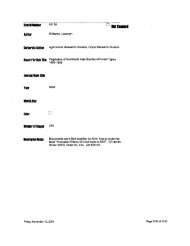Epidemiologic Investigation of Health Effects in Air Force Personnel ...
Epidemiologic Investigation of Health Effects in Air Force Personnel ...
Epidemiologic Investigation of Health Effects in Air Force Personnel ...
Create successful ePaper yourself
Turn your PDF publications into a flip-book with our unique Google optimized e-Paper software.
e<strong>in</strong>g preferred. If for example, the mortality rate <strong>in</strong> C 1 is 0.10, then an<br />
unaccountability rate <strong>of</strong> 0,01 could alter the mortality rate by as much as<br />
10%. Whatever the unaccountability rates, the pattern <strong>of</strong> unaccountability<br />
must also be compared between groups R 1 and C'. For example, the possibility<br />
<strong>of</strong> age differences must be exam<strong>in</strong>ed, particularly if the unaccountability<br />
rates are high. The follow<strong>in</strong>g paragraphs discuss the analysis <strong>of</strong> mortality<br />
under the assumption that low unaccountability rates have rendered the mortality<br />
analysis mean<strong>in</strong>gful.<br />
Multiple mortality assessments will be accomplished dur<strong>in</strong>g<br />
the course <strong>of</strong> this study, one at the beg<strong>in</strong>n<strong>in</strong>g <strong>of</strong> the study, us<strong>in</strong>g available<br />
mortality data on the basic mortality cohorts <strong>in</strong> C 1 and R 1 (5:1 ratio), and<br />
others us<strong>in</strong>g mortality data on R 1 and all controls used <strong>in</strong> the study (both C 1<br />
and replacements) as controls accumulate prospectively. The procedures<br />
described here will be used <strong>in</strong> all <strong>of</strong> these assessments.<br />
Henceforth, with<strong>in</strong> the protocol, the term "mortality data"<br />
does not dist<strong>in</strong>guish between that data collected <strong>in</strong>itially and that data collected<br />
<strong>in</strong> the future.<br />
The mortality data will be analyzed us<strong>in</strong>g several different<br />
approaches. Crude age-specific death rates will first be calculated and<br />
tabulated. Age will be d-jvided <strong>in</strong>to k strata, and person-years will be<br />
observed for each strata as will be the number <strong>of</strong> deaths <strong>in</strong> each strata. In<br />
this manner a tabular display will be developed as shown <strong>in</strong> Table 7.<br />
Table 7<br />
STRATIFIED FORMAT OF AGE-SPECIFIC DEATH<br />
RATES<br />
Ranch Hand<br />
Controls<br />
Person<br />
Years<br />
Deaths<br />
Death<br />
Rate<br />
Person<br />
Years<br />
Deaths<br />
Death<br />
Rate<br />
1<br />
2<br />
PH<br />
Pl2<br />
m 12<br />
P 2 i<br />
P 22<br />
m 22<br />
P21<br />
r 22<br />
PIS<br />
m !3<br />
m 23<br />
P23<br />
"Ilk<br />
•"ik<br />
S<strong>in</strong>ce the death rates TIJ and r 2 j are Poisson variables, they<br />
can be contrasted directly. If the relationship <strong>of</strong> rjj to r 2 j is found to<br />
be consistent between age strata (with<strong>in</strong> statistical variability), a summary<br />
mortality <strong>in</strong>dex may be calculated. One summary <strong>in</strong>dex that will be calculated<br />
is the Standardized Mortality Ratio (SMR) which is (Armitage, 1971):<br />
32
















